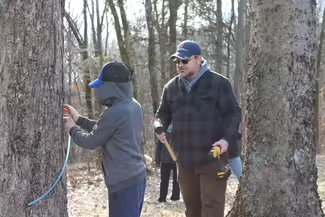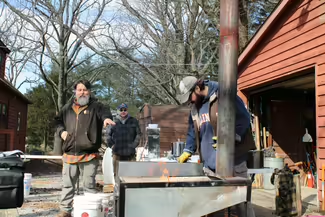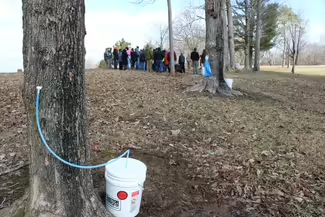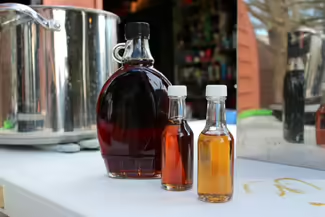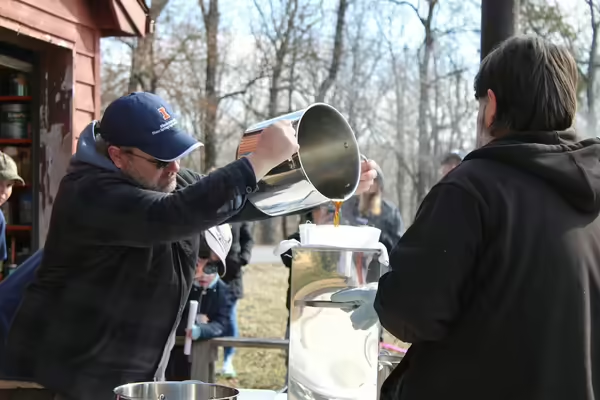
SIMPSON, Ill. — Maple syrup is a one-ingredient food. Only one thing goes into making it: the sap of maple trees collected in early spring. Every year in late January, the University of Illinois Extension Dixon Springs Agricultural Center in southern Illinois welcomes hobbyists and those interested in making their own maple syrup to a workshop where they can get up close with the sweet treat.
This year, Extension foresters Chris Evans and Kevin Rohling provided tours and live demonstrations of the research center’s stand of 100 tapped maple trees, from how to remove the sap to how to process it into syrup. Visitors could also get a taste of maple syrup made on-site with a 4-H pancake breakfast.
Where does maple syrup come from?
Trees make up energy from their leaves and get water and nutrients from their roots. Sap serves as the transport system in a tree, with the sugary liquid moving energy and nutrients throughout. While all trees have sap, the syrup we know and love comes from maple trees. The sugar maple has the highest amount of sugar, but the sap from other varieties of maple, such as silver maple, red maple, or even box elders, also produce a similar taste.
When should you collect maple sap?
Trees store up energy over the fall and into winter in preparation for the spring, so the sap is the most abundant and sweetest in late winter. The timing is important; it needs to be warm during the day with cold, below-freezing temperatures at night. That repeated freeze-thaw cycle causes sap to move up and down through the trees.
In southern Illinois, the season runs approximately from the first week of January into the last week of February. Those dates will be later the farther north you travel. After that, the sap won’t flow as well, and it will also start to taste bitter as chemical changes begin to take place to prepare the tree for springtime.
How is maple sap collected?
Getting sap from the maple tree requires tapping it. A tree 10 to 15 inches in diameter can support a single tap, and you can get 5 to 15 gallons of sap per tap. Using a sharp drill bit, make a small hole 1-2 inches deep at an upward angle. Taps, or spiles, are inserted into the hole with a gentle hit from a rubber mallet. A bucket can be hung directly on the spile or premade kits are available for purchase. For larger operations, plastic tubing can be installed that leads to a five-gallon bucket and lets gravity do the work. Once the spiles are removed after syrup season, the holes seal over, and there is no damage or harm to the tree and trees can be tapped again next year.
How do you make sap into syrup?
On average, it takes over 40 gallons of sap to make a gallon of maple syrup. Collected sap must be boiled to remove the water, making it concentrated, thicker, and sweeter. At DSAC, boiling is a two-step process, with the first boil done outdoors over a large stainless-steel boiler. Once the syrup is reduced, it goes inside where it is boiled on a stovetop for closer observation until it reaches a 67% sugar content.
At this stage, the syrup is filtered to remove any ash, sugar rocks, or debris. Then, it is reheated to 190 to 200 degrees and bottled. Sealed syrup stored in a cool, dark place is shelf-stable for up to a year, making it an enjoyable treat year-round.
To learn more about maple syrup production, contact Chris Evans or Kevin Rohling. Watch a full series of videos on maple syrup production on the Illinois Extension Forestry YouTube channel or visit their website at extension.illinois.edu/forestry.
University of Illinois Extension develops educational programs, extends knowledge, and builds partnerships to support people, communities, and their environments as part of the state's land-grant institution. Extension serves as the leading public outreach effort for University of Illinois Urbana-Champaign and the College of Agricultural, Consumer and Environmental Sciences in all 102 Illinois counties through a network of 27 multi-county units and over 700 staff statewide. Extension’s mission is responsive to eight strategic priorities — community, economy, environment, food and agriculture, health, partnerships, technology and discovery, and workforce excellence — that are served through six program areas — 4-H youth development, agriculture and agribusiness, community and economic development, family and consumer science, integrated health disparities, and natural resources, environment, and energy.
